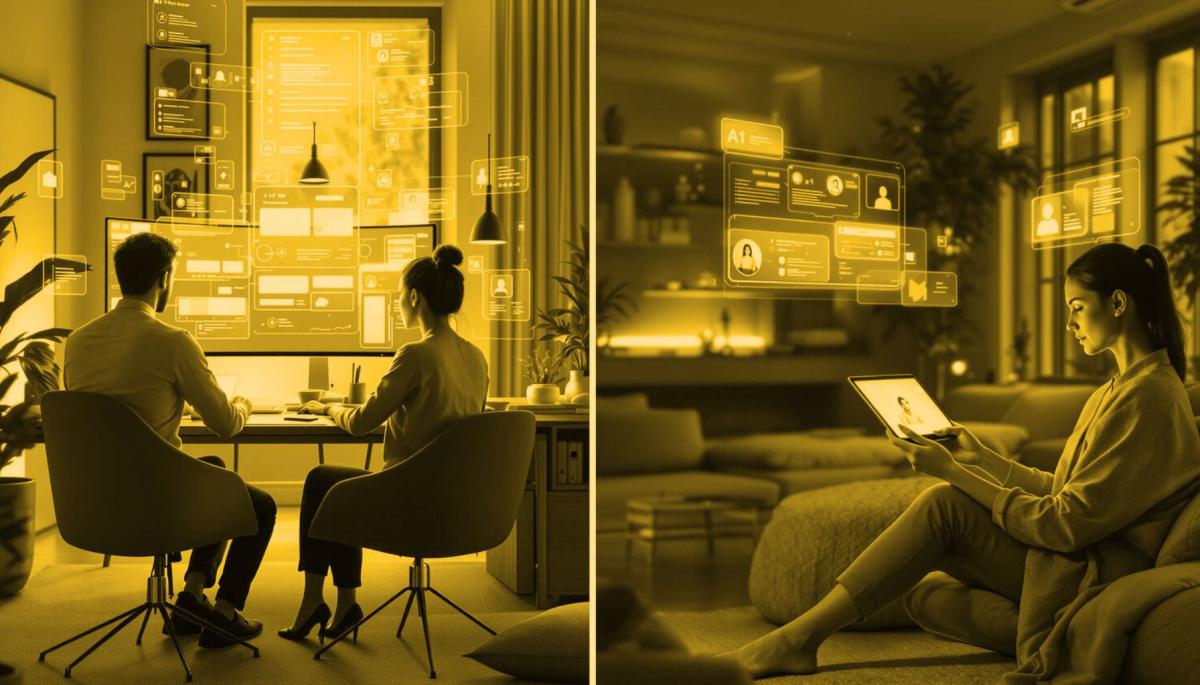ChatGPT has changed the world of artificial intelligence, but it's not the only player in the AI assistant field. Discover five intriguing alternatives with different focuses – from analytical Claude to the versatile Gemini and the European Mistral. Each excels in different areas and offers you distinct functionalities.

A silent revolution has been occurring in the digital space over recent years. ChatGPT by OpenAI became a phenomenon that drew the attention of millions of users and demonstrated how large language models can make our work easier. Meanwhile, a range of competing solutions has emerged, each with its pros and cons. Join us as we explore 5 alternatives to ChatGPT.
-
Claude
Claude, developed by Anthropic, represents one of the most interesting alternatives to ChatGPT. This assistant was created by former OpenAI researchers who decided to take their own path, focusing on what they call Constitutional AI – an approach aimed at creating reliable and ethical artificial intelligence.
Technological Background
Claude excels particularly in processing large texts. While the standard version of ChatGPT handles a few thousand tokens (roughly corresponding to words), Claude can work with contexts containing up to 200,000 tokens.
In practice, this means you can present him with entire books, lengthy research papers, or extensive documents, which he can analyze in a continuous context. This capacity makes it an ideal tool for lawyers analyzing contracts, researchers reviewing scholarly literature, or writers working with extensive texts.
Claude was designed with extraordinary focus on factual accuracy. In tests, it often shows a lower tendency towards hallucinations (creating false but convincingly sounding information) than its competitors. When Claude doesn't know something, it is more likely to admit it openly rather than attempting to create a conjectured answer.
Personality and Communication Style
What users often appreciate about Claude is its communication style. Unlike some competitors whose responses may seem sterile or too formal, Claude can communicate more naturally and with a subtle sense of humor, without slipping into unprofessionalism.
Availability and Versions
Anthropic offers Claude in several versions. The latest generation of models (Claude 3) comes in variants like Haiku, Sonnet, and Opus, differing in performance, precision, and speed. The basic version is available for free, while more advanced features and options require a Claude Pro subscription.
Many users also appreciate the integration of Claude into various third-party applications through an API.
Limitations and Disadvantages
Despite all its advantages, Claude also has its limits. Unlike some competitors, it doesn't have direct access to the internet for searching current information by default. Its knowledge is limited to training data, which can be an issue when querying about the latest events.
For some users, the lack of advanced code generation features offered by tools like GitHub Copilot or advanced versions of ChatGPT may also be a barrier.

-
Gemini
When the tech giant Google introduced its tool Bard, later renamed Gemini, in 2023, it marked a crucial moment in the evolution of conversational AI.
Technological Background
Gemini represents the pinnacle of Google's years of research in artificial intelligence. Unlike many competitors, this model was designed from the ground up as multimodal – meaning it can work not only with text but also with images, sound, and eventually video inputs.
The model excels in processing structured data and retrieving relevant information. When a user poses a complex query, the model often utilizes its access to the Google search engine to obtain current and relevant information. It then processes, filters, and presents these results clearly.
Personality and Communication Style
Gemini is characterized by a friendly yet informative communication style that strikes a balance between informality and professionalism. Unlike some competitors that may seem either too formal or overly familiar, Gemini can naturally adjust the tone of the conversation to suit the situation.
Availability and Versions
The model exists in three main variants – Gemini Ultra (the most powerful version), Gemini Pro (a balanced model for most applications), and Gemini Nano (a lightweight version designed for mobile devices). This strategy allows for the deployment of the AI assistant across various platforms with consideration for available computational power.
Integration with the Google Ecosystem
The real strength of Gemini lies in its integration with other Google services. While competing models often function as isolated tools, Gemini is interconnected with the entire ecosystem.
- Access to current information – Thanks to its connection with the Google search engine, Gemini has access to the latest information on the web. Unlike ChatGPT, whose knowledge is limited to training data, Gemini can provide current news, sports results, or the latest scientific discoveries.
- Gmail and Google Docs – Gemini can analyze your emails, create summaries, or assist with drafting responses. In Google Docs, it can assist with writing, editing, or suggesting style and formatting changes.
- Google Maps and Calendar – The assistant can connect with your calendar and maps, allowing for travel planning, meeting organization, or searching for locations.
- YouTube and Google Photos – Gemini can work with content from both platforms, analyze videos or photos, and provide relevant information based on visual content.
Limitations and Disadvantages
Gemini also has its weaker aspects that are worth mentioning. Sometimes it gives different answers to the same question depending on how it's phrased, which can be confusing. It also tends to be overly cautious – with more sensitive topics, it prefers not to answer at all. Some users also complain that it responds more slowly than the competition on more complex tasks.
-
Perplexity AI
Perplexity AI is an interesting hybrid between a traditional search engine and conversational artificial intelligence. Unlike classic chatbots, it is primarily designed for searching and verifying facts, supplementing each answer with source links.
Technological Background
Perplexity operates on the principle of combining language models and search technologies. The system uses its own models but also integrates technologies from companies like OpenAI or Anthropic.
This approach allows it to combine the ability to answer questions naturally with the capacity to search current sources online. This is particularly useful for queries about current events, new products, or research.
Personality and Communication Style
Perplexity communicates in a more matter-of-fact, informative style that emphasizes facts over conversational fluency. Unlike some competitors, it doesn't strive to seem overly human or entertaining – its main goal is to provide accurate, well-substantiated information. Answers are therefore structured in straightforward paragraphs with clearly marked sources.
Availability and Versions
Perplexity AI is available in several variants, differing in features and price. The basic version is free and allows a limited number of queries daily with access to most features.
For more demanding users, there is a Perplexity Pro subscription offering advanced models, higher limits, the ability to upload files, and other bonus features. The service is accessible via a web browser and mobile applications for iOS and Android.

-
Microsoft Copilot
Microsoft Copilot emerged as a fusion of a traditional search engine and conversational AI. It is built on the technology of OpenAI (like ChatGPT) and is integrated into Microsoft's tools.
Technological Background
Copilot is powered by the latest language models from OpenAI, specifically variants of GPT-4. Due to Microsoft's investment in OpenAI, it gained access to these advanced technologies, complementing them with its own enhancements.
The greatest advantage of Copilot is its close integration with the Microsoft ecosystem – it can work directly with your documents, emails, spreadsheets, and other data within Microsoft 365.
Personality and Communication Style
Copilot communicates in a professional yet friendly style, designed to fit well into a work environment. Its tone is factual and helpful, avoiding excessive emotions or overly informal communication. Answers are usually structured and focused on solving specific tasks.
Within Microsoft 365 applications, it adapts its style to the given context – in Outlook, it assists with concise email communication, while in PowerPoint, it offers creative ideas for presentations.
Availability and Versions
Microsoft offers Copilot in several variants. The basic version is available for free as part of the Bing search engine and Edge browser. Full utilization within Microsoft 365 requires a Copilot Pro subscription (for individuals) or Copilot for Microsoft 365 (for businesses).
With it, you gain advanced features in applications like Word, Excel, PowerPoint, Outlook, and Teams. Microsoft also offers specialized versions like GitHub Copilot for developers or Copilot for Security for security teams. For regular users, Copilot is available on most platforms, including Windows, macOS, iOS, and Android.
Mistral
In 2023, a new, ambitious player from Europe entered the artificial intelligence scene. French startup Mistral AI, founded by former researchers from Meta AI and Google DeepMind, quickly caught the attention of the tech world not only for its European origin but mainly for its approach to the development and distribution of large language models.
Technological Background
Mistral develops its language models with an emphasis on efficiency and performance. While competitors often rely on massive models with trillions of parameters, Mistral focuses on smarter architecture that achieves comparable results with fewer parameters.
Their Mistral 7B model, for example, managed to match much larger models in various tests, despite having 'only' 7 billion parameters.
The company also utilizes advanced techniques like mixture of experts in their Mixtral model, allowing the activation of only relevant parts of the model depending on the task type. This approach saves computational power and energy, making Mistral models suitable for deployment on less powerful hardware or mobile devices.
Personality and Communication Style
Mistral models communicate in a factual and straightforward manner. Users appreciate that the models do not come across as overly American and better understand European realities. Mistral's communication style is adaptable – formal in professional contexts, and able to adjust the tone to your requirements in informal situations.
Availability and Versions
What sets Mistral apart is its more open approach. The company offers some of its models as open-source, allowing developers to modify and deploy them according to their own needs. Core models like Mistral 7B and Mixtral 8x7B are freely available, while the more advanced Mistral Large model is accessible via API.
Mistral is also available through partner platforms like Microsoft Azure, Amazon Bedrock, or Hugging Face, facilitating its implementation.
The best way to find the ideal AI assistant is to try several different tools and see which one best suits your work style and needs. Most of them offer trial or limited versions that will hint if they are right for you.
What will 6G internet bring – lightning-fast connection, smart cities, and artificial intelligence in the network

Mobile networks of the sixth generation will push the boundaries of communication and data transmission. 6G internet will offer speeds in the order of terabits, minimal delay, and integration with artificial intelligence. In the article, we explain how this technology works, how it differs from 5G, what frequencies it uses, and why it is essential for smart cities and modern industry.
Wireless charging: What are its benefits, limitations, and where is it heading?

Wireless charging has evolved from a luxury feature to a standard part of most modern phones. Simply place your mobile on the pad, and energy begins to flow without searching for a cable and connector. We explain how wireless charging works, what it entails, and why Qi and Qi2 technologies have become the new standard of convenience.
What is Wi-Fi 7? What changes does it bring and when does it make sense to switch

Today's home Wi-Fi network is under increasing pressure. It has to handle video calls, online gaming, and dozens of smart devices. The new Wi-Fi 7 standard offers a solution that takes wireless connectivity to the next level. We'll explain what this standard means in practice and why it might be crucial for the future of home and business networks.
What is DNS? Everything you need to know about its functionality and setup

When you type a website address into the browser, the correct page loads in an instant. This is managed by the DNS system, without which the internet as we know it would not exist at all. In this article, you will learn what DNS is, how it works, what types of records it contains, and why it is important for both speed and security of the connection.
How does fiber optic internet work and what do you need for its installation?

Fast and stable connection is a basic necessity in every household today. The solution is fiber optic internet, which works differently than regular cables and offers greater reliability to users. We'll explain how this technology works in practice, what it entails to run a fiber optic cable to your home, and what equipment you’ll need to keep everything running smoothly.
Cloud gaming – the end of consoles in sight?

Cloud gaming allows you to play games from anywhere without the need for expensive hardware. In this article, you'll learn how game streaming works, what advantages and limitations it brings, and which services are leading the way today. And most importantly: can it really threaten traditional consoles?